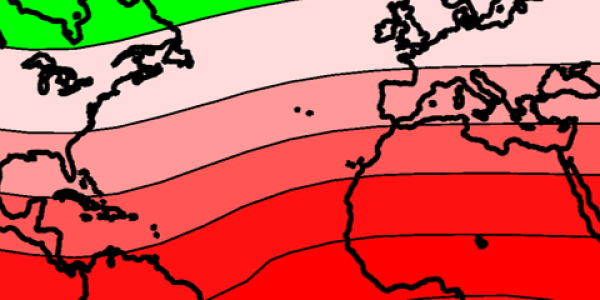The Special Sensor Microwave Temperature (SSM/T)-2 sensor is a five channel, total power microwave radiometer with three channels situated symmetrically about the 183.31 GHz water vapor resonance line and two window channels. This instrument was flown on all Defense Meteorological Satellite Programs (DMSP) Block 5D-2 satellites starting with F11 launched in 1991. SSM/T-2 provides global monitoring of the concentration of water vapor in the atmosphere under all sky conditions by using the reduced sensitivity of the microwave region to cloud attenuation.
The SSM/T-2 is a cross-track scanning, five channel, passive total power microwave radiometer system which consists of a single, self-contained module with a step-scan motion in the cross-track direction of +/- 40.5 degrees. The SSM/T-2 scan mechanism is synchronized with the SSM/T-1 so that the beam cell patterns of the two sensors coincide. The SSM/T-2 observation rate is 7.5 scans per minute. There are 28 observations (beam positions) per scan for each of the five channels, with each observation having a spatial resolution of approximately 48 km. All five channels have coincident centers. The total swath width for the SSM/T-2 is approximately 1500 km.
The SSM/T-2 employs a single offset parabolic reflector with a 2.6 inch diameter projected aperture. The reflector is shrouded to eliminate the possibility of rays from the sun striking either of the calibration paths and causing unwanted thermal gradients. The feedhorn is a corrugated pyramidal horn with a flare designed to minimize phase center separation over the bandwidth (91 to 183.3 GHz), while providing a spherical wave illumination of the reflector. To achieve the cross-track scanning, the reflector alone rotates. The rotation of the reflector produces a rotation of the plane of polarization of the upwelling scene TBs which is permitted provided that the polarization remains identical for the two window channels and 183.3 +/- 7 GHz. These channels must have the same polarization characteristics because they measure contributions from both the atmosphere and the surface. Note that all SSM/T-2 channels possess the same polarization.
During each scan period, and for all five channels at twenty-eight discrete earth viewing positions, four discrete calibration measurements of a hot-load target (~300K), and cosmic background radiation (~3K) are monitored.
The SSM/T-2 inflight warm-load calibration target is a derivative of the SSM/T-2 warm load calibration target. The warm load (~300 K) is shrouded to improve radio frequency (RF) coupling of energy to the reflector/feedhorn antenna. This minimizes potential calibration errors arising from the reception of extraneous energy due to scattering of earth or solar radiation off of the spacecraft. The cold path is a cylindrical oversized waveguide tube which permits a direct view of the cosmic background (~3 K) by the antenna reflector during calibration.
The periodic calibration data are modeled by a linear transfer function to characterize the state of the total power radiometer and remove time variations of the receiver gain and offset for frequencies less than half the reciprocal of the calibration period. As a consequence, relatively large temperature related receiver gain drifts are taken into account in the periodic construction of the transfer function. The minimal detectable temperature difference is 0.45 K. The SSM/T-2 employs a calibration period of 8 seconds in which four samples are taken of a warm-load calibration target along with four samples of the cosmic background.
The imaging of SSM/T-2 data offers a new perspective on the atmosphere that complements other remotely sensed datasets. Conlee (1995, Texas A&M Dissertation) shows that major mid-latitude weather phenomena such as fronts and extratropical cyclones have excellent signatures in SSM/T-2 data, including three-dimensional structure. Other phenomena such as as tropical cyclones, tropical plumes, subtropical anticyclones and surface states such as sea ice and snow cover may be identified.
Applications other than profiling are possible with the SSM/T-2. The retrieval of vertically integrated water vapor is also possible due to the strong sensitivity of the 183.31 GHz water vapor absorption line.



